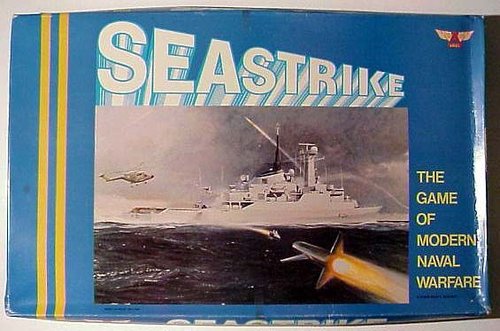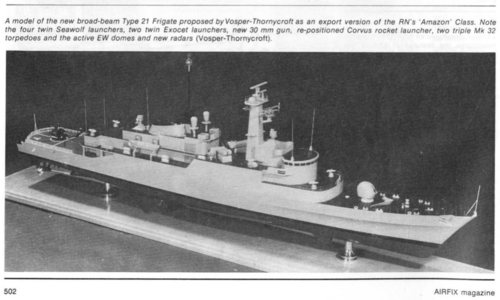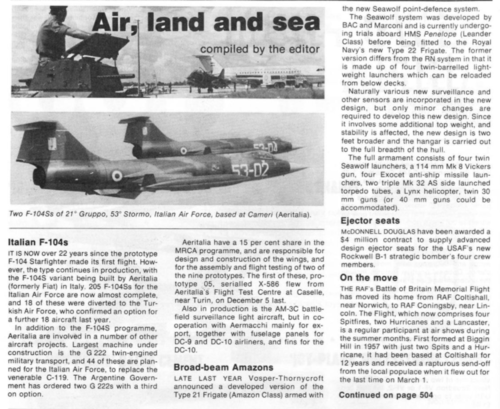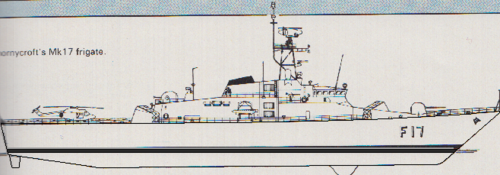I have never come across the Broad-Beam Type 21 before. I wonder if it was simply a marketing concept rather than a genuine export market attempt? By 1976 the Vosper Thornycroft series had moved on some way and why bother when the Mk.10 Niteroi had already opened the way to a larger and more capable design.
I attach an image of the Mk.17 which dates from 1982 to illustrate my point.
I got to thinking about the Type 21 design saga so started to sift through the various designs of the Vosper family tree as well as those proposed for the Type 19 and joint RN/RAN requirements. I added Yarrow's efforts of the time too for comparison.
Vosper 1962 Corvette (offered to RCN, made public 1963) – 177 x ? ft, Olympus-Deltic CODOG for 50kt
Vopser Mk.1 – 440 tons, 177 x 28.5ft, 1x 4in, MTU or Paxman diesels for 20-18kt
Vosper Thornycroft Mk.3 – 580 tons, 202 x 31ft, 1x2 4in, MAN diesels for 22kt
Vosper Thornycroft Mk.5 Saam – 1,100 tons, 310 x 36.3ft, 1x 4.5in & 1x2 35mm & Limbo & 1x5 Sea Killer, Olympus-Paxman CODOG for 39kt
Vosper Thornycroft Mk.7– 1,360 tons, 333 x 38.3ft, 1x 4.5in & 1x2 35mm & 1x Albatros Aspide & 4x Otomat, Olympus-Paxman CODOG for 37.5kt
Vosper Thornycroft Mk.9 – 680 tons, 226 x 31.5ft, 1x 76mm, Bofors A/S mortar, 1x Sea Cat, MTU diesels for 27kt
Type 19 – 1,900 tons, 340 x 35ft, 1x 4.5in, 1x Seacat, 1x helicopter, Olympus-Paxman CODOG for 39kt
DS919 – 1,200 tons, 260 x 33ft, 1x 4.5in, PX.430, 1x helicopter (pad only), Olympus-Tyne COGOG for 28kt
DS920 – 1,200 tons, 270 x 33ft, 1x 4.5in, PX.430, 1x helicopter (pad only), Olympus-Tyne COGOG for 28kt
YARD Y.217 (for RAN) – 2,070 tons, 1x 5in/54, 1 Sea Sparrow, 1x helicopter, Olympus-Tyne COGOG for 35+kt
Type 21 – 3,100 tons, 384 x 41.7ft, 1x 4.5in & 1x Sea Cat & 4x Exocet, 1x helicopter, Olympus-Tyne COGOG for 30kt
‘Broad-Beam’ Type 21 – 1976, 3,100+ tons, 384 x 43.7ft, 1x 4.5in & 4x2 Sea Wolf & 4x Exocet, 1x helicopter, Olympus-Tyne COGOG for 30kt(?)
Vosper Thornycroft Mk.10 Niteroi – 3,200 tons, 424 x 44.2ft, 1-2x 4.5in & Bofors A/S mortar & 2x Sea Cat & 2-4x Exocet & 1x Ikara (10x missiles) [replacing 1x 4.5in], 1x helicopter, Olympus-MTU 16V CODOG for 30kt
Yarrow Rhamat –1,250 tons, 308 x 34.1ft, 1x 4.5in & Limbo & 1x Sea Cat, Olympus-Crossley CODOG for 26kt
Yarrow Makut Rajakumarn –1,650 tons, 320 x 36ft, 2x1 4.5in, 1x Albatros Aspide, Olympus-Crossley CODOG for 26kt
Some things stand out;
The fast corvette offered to Canada in 1962 to replace the Bras D'Or programme seems to have been the genesis of the series, removing the turbine made a nice corvette design that started the ball rolling on the export corvette series.
The Type 19 was certainly of the right ballpark figure for the kind of export frigates then being designed by Yarrow and VT. The high speed was the outlier but certainly speed seems to have become an asset not just for hunting Indonesian 'Osas' but also in terms of attractiveness to export nations - both Libya and Iran saw high speed a price worth paying for. I can't see how the Type 19 would have achieved 39kt on 1,900 tons, that sounds very ambitious, I would think 37kt would be more realistic in practice.
The cost-cutting DS919 and DS920 were relations even compared to export designs, being quite small - though in fairness they were described as patrol vessels.
Its easy to see why the Mk.5 and the slightly later Mk.7 made such an impression on the Admiralty, their avoidance of Mil-Spec requirements enabled them to be piled high with goodies at the expense of other other factors (habitability, ammunition, damage control). Its a wonder that they didn't think 'it must be too good to be true' when they looked at the Mk.5s specs. The Mk.7 actually looks much more of a realistic design overall.
The RN/RAN requirements were incomparable but I think that it had a far more beneficial impact than we give credit for. The Type 19 was heavier but physically not much larger or more capable than the Mk.7. But the RAN's range requirements and armament choices pushed the concept up in terms of size and weight and beyond its Mk.5 competitor. The Type 21 proved to be cramped with little growth but it can be seen that without RAN involvement, that a UK non-commercial solution like the Type 19 would have come out about 1,000 tons lighter and maybe 40ft shorter and maybe as much as 5ft slimmer. Actually it can be seen that the VT export designs were beamier overall, regardless of displacement.
A larger Type 21 would seem unlikely in the circumstances, it was probably as big as was acceptable to the eyes of the late 1960s. The Type 21 had no export success, the Niteroi was the biggest the series got. In terms of exports the sweet spot was around the 1,000-1,400 ton ballpark at that time.




